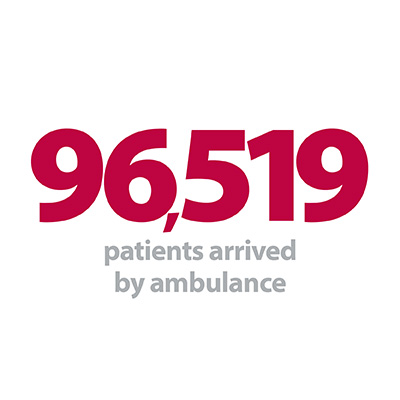
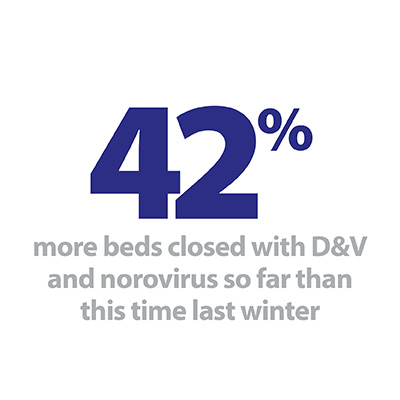
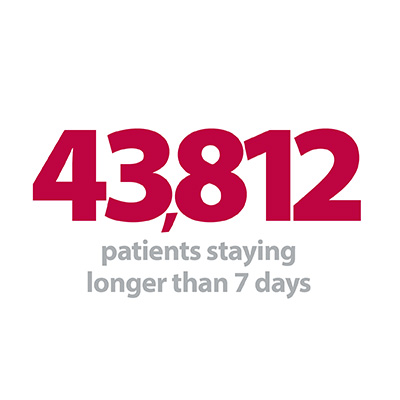
Week nine of the winter sitreps was released today, and from the data it is clear trusts continue to face very testing conditions throughout the country. Despite the relatively mild weather demand is exceptionally high as more patients than ever require care.
Bed occupancy rose by half a percentage point to 94.8% this week; and there was also a considerable increase in the number of patients arriving by ambulance following several weeks of this figure falling. Concerns remain that cold weather and additional demand from flu could make the remaining weeks of winter extremely tough. Trusts also face additional operational pressures from the need to manage any risk presented by coronavirus.
Key headlines from week nine:
- Bed occupancy is 94.8%, up from 94.3% last week - worryingly high given the relatively mild weather.
- There were 4,044 escalation beds open, up 5% on last week (184 more beds), but 9% lower than the high point in week six (397 fewer beds).
- D&V and norovirus resulted in an average of 775 beds closed every day this week, high but no change from last week.
- There were 96,519 ambulance arrivals this week, 2,818 more than last week (3% more).
- Also more handover delays this week – of all patients arriving by ambulance, 14.3% were delayed by 30 minutes or more (up from 11.1%), and 3.0% were delayed by 60 minutes or more (up from 2.0%).
- Length of stay was similar to last week on each of the 7, 14 and 21 day measures, but these all remain much higher than last year and are approaching the levels seen in the very challenging 2017/18 winter.
Trusts are doing all they can to keep patients flowing through their wards and settings, but typical of this point in the winter there are significant numbers of patients who have to stay longer because of the severity of their illnesses. The high number of patients staying longer than 7, 14 and 21 days, coupled with an increase in ambulance arrivals this week has led to the overall bed occupancy rising towards the highest levels seen this winter.
The 2020/21 planning guidance sets a new target of bed occupancy to be under 92% from April 2020.
The 2020/21 planning guidance sets a new target of bed occupancy to be under 92% from April 2020. Alongside this is the ask for all trusts to open more beds in line with the additional capacity they open over winter. However, if applied retrospectively, we can see that 122 trusts reached 92% this week, and over a hundred trusts topped 95% as the system stretches to meet the huge demand for its services.
In 2018/19, reducing length of stay was a particular policy focus nationally and trusts worked hard with system partners to make significant progress. This followed the difficult 2017/18 winter, where weather conditions were brutal and unprecedented numbers of patients had their transfers into more appropriate care settings delayed. So far this winter, there have been a total of 388,175 patients staying longer than 7 days, 5.4% higher than the equivalent in 2018/19, but 2.9% lower than the aforementioned 2017/18 winter. We also know there has been an increase in delayed transfers of care which could suggest community and social care capacity is struggling to keep up with demand. However, to be approaching similar levels now in a winter yet to feel the full force of bad weather and seasonal illness is cause for concern.
This week in our guest contribution we hear from Maxine Power, who is director of quality, innovation and improvement at North West Ambulance Service NHS Trust. She outlines their approach to tackling one of the key indicators we routinely focus on in this blog, the challenge of ambulance handover delays.
Tackling the challenge of handover delays
This week, North West Ambulance Service NHS Trust director of quality, innovation and improvement Maxine Power discusses ambulance handovers and delays amid winter pressures, and how to tackle these challenges and reduce repercussions.
For most people going to an A&E or calling an ambulance is a rare event. We trust ourselves into the hands of paramedics, nurses and doctors whose job it is to respond quickly, assess the problem, stabilise and choose the most appropriate immediate care response for the patient.
For those who call 999, around 70% of patients are transported to hospital on blue lights and sirens with the expectation that they will then be rapidly assessed by hospital staff in the A&E department.
For those who call 999, around 70% of patients are transported to hospital on blue lights and sirens with the expectation that they will then be rapidly assessed by hospital staff in the A&E department. Anticipation is high and the need to act quickly is implicated in the nature of the transfer. There is no doubt that for those with the most life threatening conditions the system works well. The NHS is at its best.
The figures released today bring into sharp focus the demand for urgent and emergency care which has increased exponentially year on year. Today, demand is rooted in chronic disease, old age and social deprivation and is often reported to overwhelm the resources available in A&E on a daily basis.

This groundswell of patients has also impacted on the ambulance service who battle valiantly to work with out-of-hours providers to offer alternatives to hospital care. Inevitably, some end up in A&E. These patients, the ones with urgent but not life-threatening conditions, are the ones who are at risk of delays. Hospital systems are designed to deliver care to the sickest first, not those who arrived first.
As an NHS leader I completely understand how, and why, the system works the way it does. I worked in hospitals for over 30 years, I get it. Over the last two years I have seen the system through a different lens. I’ve been focused on the process of handover between ambulance staff and A&E. I've seen the handover process slow down as A&E departments get busier and busier. A phenomenon which, whilst reported nationally, has remained less visible than the four hour wait for patients who walk into A&E.
Ambulance crews should be able to hand a patient over to the A&E team in 15 minutes but many wait several minutes or hours for a member of the A&E team to take their handover. This manifests as queues of patients waiting on trolleys in corridors accompanied by ambulance staff and is an iconic image of A&E pressure often used within the media to illustrate demand.The real question that surfaces is – what impact do these delays have and does it really matter? After all it's only a few minutes per patient? In the first four weeks of this winter's reporting period starting on 2 December, there were 399,528 ambulance attendances to hospitals in England with 46,525 of these ending in delayed handovers between 30 and 60 minutes and 16,236 delayed by 60 minutes or more. The aggregate numbers of lost hours are staggering. The tidal rise is worrying and unrelenting.
NHS England and NHS Improvement have provided specific consultancy and support to the most challenged A&E departments and in January 2019 updated guidance for local A&E delivery boards reinforced the national standard of 30 minutes for hospital turnaround, expectations around escalation planning at times of high demand and zero tolerance to corridor care. Despite this there remains wide variation in local performance. Whatever we are doing to address this issue – it’s not working and in the winter of 2019-20 this issue has become a ministerial priority.
The winter of 2018 was my first as an ambulance service leader. Winter hit hard and the pressures were felt throughout the system. I saw firsthand the queues of patients waiting for assessment and treatment. That new year’s eve I visited over 10 hospitals and saw staff battling to provide care against overwhelming demand. Some patients saw the new year in on cold corridors. One patient, when asked "is there anything I can do for you?" replied: "I haven't had a hot drink for eight hours". That was 3am in our NHS on a new year's eve. I saw the kind of breakdown in communications which I hadn't observed in our healthcare system before, staff refusing to look up for fear of another 'job'. I vowed that night to do something to help and to never have a repeat of that evening ever again.
During the first three months of 2018 North West Ambulance Service reported over 30 serious incidents to NHS Improvement, compared with an average of 12 in the preceding three months.
What I hadn't appreciated was how deep the repercussions of this waiting were. Paramedics in hospital corridors can't respond to 999 calls. Back in the control centres, demand was growing and there were no resources available to send. When the dust settled I was horrified to hear that patients had come to harm because we were unable to get ambulances to them in a timely way. Never before had I seen such a stark reminder of the correlation between efficiency and patient safety.
During the first three months of 2018 North West Ambulance Service reported over 30 serious incidents to NHS Improvement, compared with an average of 12 in the preceding three months. Over 80% of these had a root cause of 'lack of resource'. I wrote countless letters back to complainants explaining that on the evening their loved one needed us 'demand simply outstripped supply' and hospital handover delays meant that crews were unable to respond.
One letter, from a complainant on behalf of her late husband, described the impact of waiting for an ambulance. She was a nurse with over 20 years' service who called us because her husband was experiencing severe chest pain. They called us again and again, waiting 1 hour and 45 minutes for an ambulance. She described how one of her sons was stood at the end of the road on the island on the central reservation waiting to flag us down so that we didn’t go to the wrong address. The minutes seemed like hours and her clinical skills were useless in the face of the symptoms presented to her. She knew that time was critical to both save her husband's life but also to prevent damage to his heart muscle. Yet we failed her, her husband and her boys. This amazing lady has become a driving force behind our 'Every Minute Matter' programme in the North West. This is a programme we started in September 2018 with our system partners to reduce the delays in hospital handover.
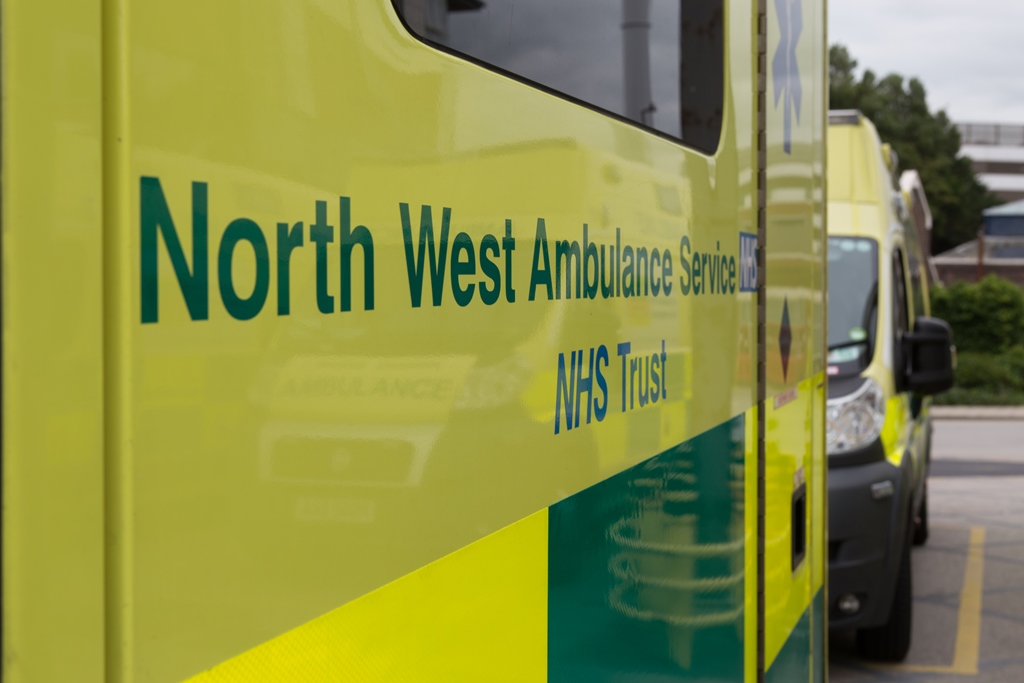
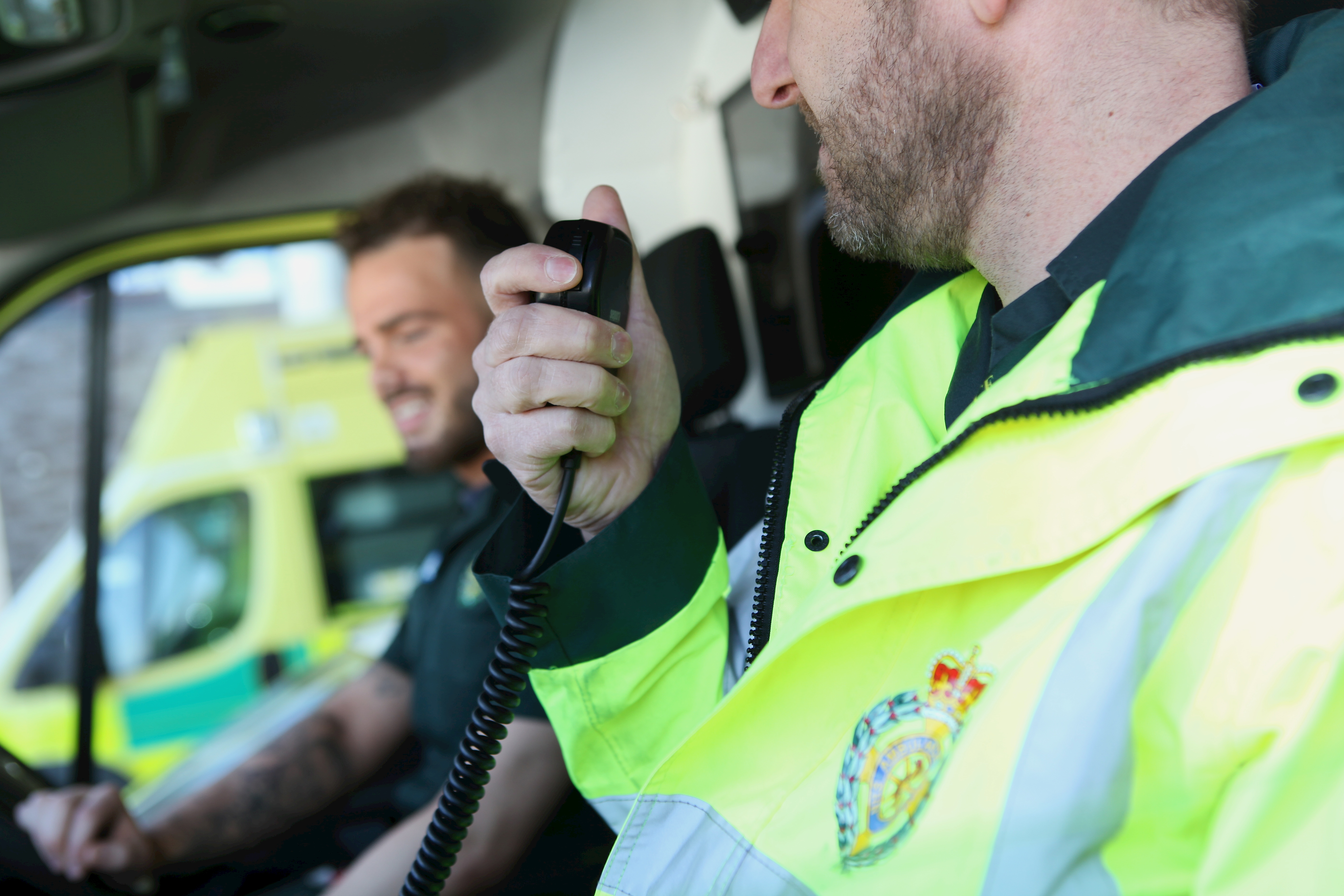
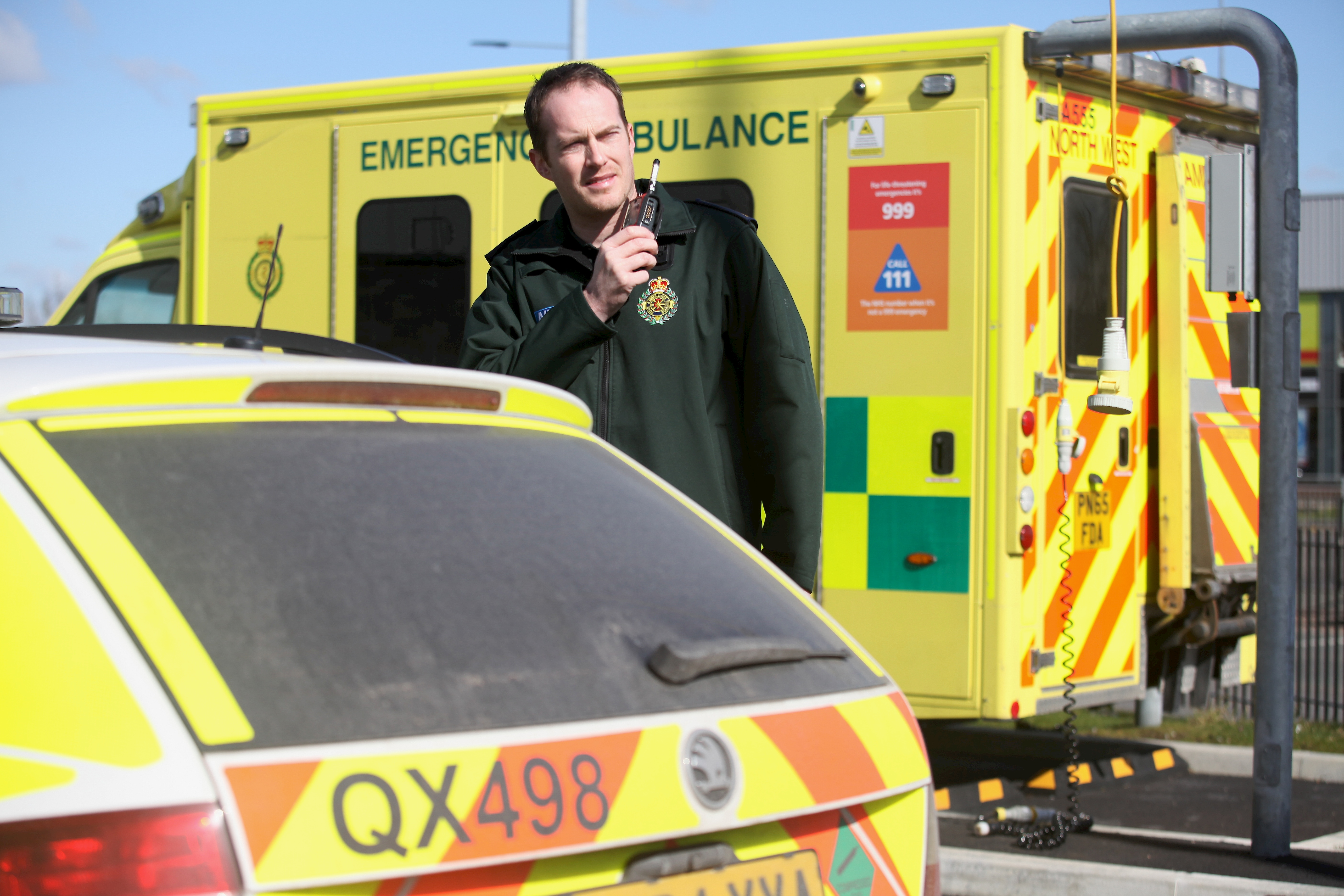
In the months leading up to winter 2018-19 North West Ambulance Service worked with six of our largest hospitals who later became known as the 'super six'. During the winter of 2017-18 they had an average ambulance turnaround time of 41 minutes and within six months this had reduced to 33 minutes. An improvement that was significantly greater than the change seen in the rest of the North West hospitals who went from 36 minutes to 33 minutes and one which cannot be explained by a reduction in demand. The 'Every Minute Matters' collaborative leadership supported teams of A&E and ambulance staff to work together to generate and test local solutions. A 15 point checklist has emerged which is now being used to scale this up to fourteen organisations across the North West throughout the winter of 2019-20.
New year's eve 2019 was a very different experience across the North West. It still isn’t perfect but I worked in Blackpool with a crew who saw 10 patients in 12 hours taking half of them to a calm A&E where handover never exceeded 10 minutes. The future can look different if we all work together to reduce delays and end corridor care. Our programme is ongoing and the learning open to all.
For more information contact: communications@nwas.nhs.uk
NHS staff are working incredibly hard amid winter pressures
Responding to the latest weekly winter reporting data published by NHS England and NHS Improvement, the director of policy and strategy at NHS Providers, Miriam Deakin said:
"These figures continue to show that week in and week out, NHS staff are working incredibly hard to meet demand and to deliver safe care. Staff are under immense pressure and the number of patients being admitted into hospitals is extremely high.
"Despite relatively mild weather this year, we are seeing pressures similar to 2017, which was the worst winter on record.
"The number of people arriving by ambulance is the highest it has been since the new year, and there are worse delays transferring patients into hospital than last week.
"After efforts by the NHS to reduce the length of time that people are spending in hospital once admitted, it is disheartening to see this increase again this year. Trusts tell us that lots of patients are very unwell and need to be in hospital. But when people are ready to be discharged we need sufficient community and social care services to ensure that patients can be treated closer to home where appropriate.
"Trusts are doing all they can to open more beds. But continued high levels of norovirus and difficulties staffing beds remain a persistent challenge every day.
"The NHS is still facing over 100,000 vacancies, and without rectifying this we cannot break the cycle of winter pressures affecting trusts’ ability to meet the growing demand.
"We look forward to working with the national bodies and trusts to support the implementation of the people plan, when published, to help trusts recruit and retain the staff they need to deliver all year round for patients."